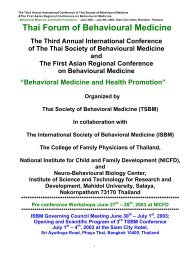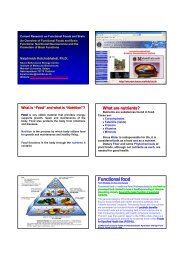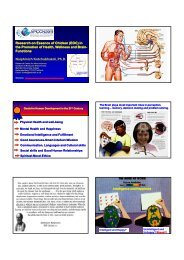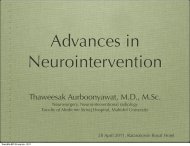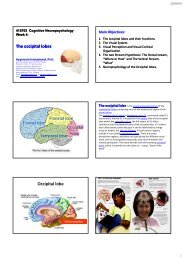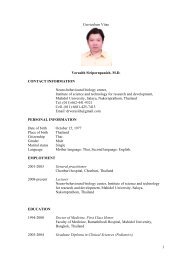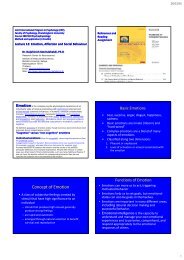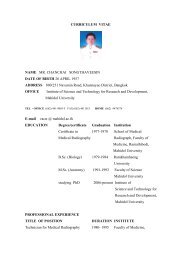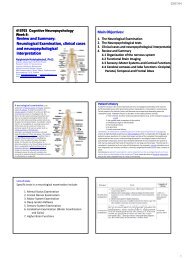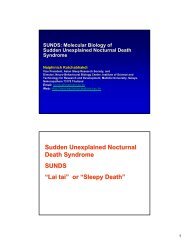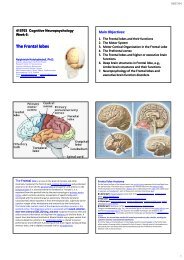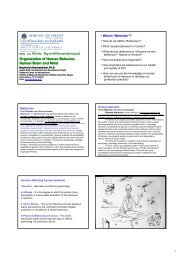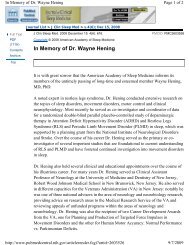PDF File - Mahidol University
PDF File - Mahidol University
PDF File - Mahidol University
Create successful ePaper yourself
Turn your PDF publications into a flip-book with our unique Google optimized e-Paper software.
Abstracts 601<br />
FP-N-015<br />
Association of single nucleotide polymorphisms in<br />
serotonin and dopamine receptor genes in autism<br />
Y.-H. Ma a , E. Nanba b , K. Takeshita b<br />
a Institute of Child and Adolescent Health, Peking <strong>University</strong>,<br />
China; b Division of Child Neurology, Institute of<br />
Neurological Science, Faculty of Medicine, Tottori <strong>University</strong>,<br />
Yonago, Japan<br />
Family and adoption studies indicate that genetic factors<br />
play a role in the development of many psychiatric disorders<br />
including autistic disorder, a severe neuro-developmental<br />
disorder that affects approximately 2–10/10 000 individuals.<br />
Although many studies have been attempted to elucidate<br />
the genetic background of autism, the genetic factors<br />
associated with its pathogenesis are still not well understood.<br />
In order to evaluate the role of SNPs in serotonin<br />
and dopamine receptor genes in autism, we performed association<br />
studies using 57 autism and 100 normal controls for<br />
SNPs with PCR-SSCP. The results showed that among 20<br />
SNPs in serotonin gene tested, 18 revealed no positive association<br />
with autism, but two SNPs in HTR1A showed significant<br />
association (P , 0:05); among ten SNPs in dopamine<br />
gene tested, seven revealed no positive association with<br />
autism but three SNPs in DRD2 showed significant association<br />
(P , 0:00001). The results indicated that difference in<br />
allele and genotype frequency of HTR1A and DRD2 may<br />
play an important role in the pathogenesis of autism.<br />
FP-N-016<br />
Phencyclidine treatment in newborn rats: behavioral<br />
and neurochemical effects<br />
X.-M. Gao, A. White, C.A. Tamminga<br />
Maryland Psychiatric Research Center, <strong>University</strong> of Maryland<br />
school of Medicine, Baltimore, MD, USA<br />
Perinatal accidents contribute to the risk for schizophrenia.<br />
Moreover, the illness may involve some abnormality of<br />
the glutamatergic system, especially of NMDA-sensitive<br />
receptor, possibly of neurodevelopmental origins. Whereas,<br />
low doses of phencyclidine (PCP) can mimic the symptoms<br />
of schizophrenia in normal humans and exacerbate symptoms<br />
in those with the illness, high doses can cause cell<br />
death, possibly due to failure of downstream GABAergic<br />
inhibition. We hypothesized that perinatal treatment with a<br />
lesioning agent, especially one directed toward the NMDAsensitive<br />
glutamate system, might result in long lasting<br />
changes in cerebral systems and abnormalities in behavior<br />
in an experimental animal and produce an informative<br />
animal preparation for schizophrenia. We treated newborn<br />
rat pups with high doses of PCP (10 mg/kg) and evaluated<br />
behavioral and neurochemical measures of CNS response in<br />
the grown rat. The rat pups were treated with a single dose<br />
of the PCP or saline on days, PN7, PN9 and PN11 (three<br />
treatments). All subjects were raised to PN42 without<br />
further treatment, sacrificed at that time, and their brains<br />
harvested for study. We used in situ hybridization to quantify<br />
gene expression for zif268, arc, GAD67, and glutamate<br />
receptor subunits (NR1, NR2A and NR2B) in this tissue.<br />
Half of the animals were assessed on PN42 their locomotor<br />
response to PCP (3 mg/kg) and for PCP disruption of<br />
prepulse inhibition.<br />
FP-N-017<br />
Sleep-disordered-breathing and child behavior<br />
J. Kohyama, W. Furushima, J.S. Ohinata, T. Hasegawa<br />
Department of Pediatrics, Faculty of Medicine, Tokyo<br />
Medical and Dental <strong>University</strong>, Tokyo, Japan<br />
Aim: To assess behavioral problems in children with sleep<br />
disordered breathing (SDB). Methods: Twenty-four children<br />
with suspected SDB (M/F 19/5, age: 4–9 years<br />
(mean, 5.5)) were studied. Their care-takers filled the Japanese<br />
version of the child behavior check-list/4–18 (CBCL<br />
(by Achenbach TM)). One-night polysomnography was<br />
done for each child. The correlation coefficients (r) between<br />
the three items on SDB (1. incidence of obstructive apnea of<br />
more than 10 s per hour of total sleep time; obstructive<br />
apnea index (OAI), 2. percentage of time with<br />
SaO 2 , 90% against the total sleep time, 3. SaO 2 nadir)<br />
and scores of ten scales on CBCL were calculated. CBCL<br />
has 113 questions that were classified into eight categories<br />
(I. Withdrawn, II. Somatic complaints, III. Anxious/<br />
depressed, IV. Social problems, V. Thought problems, VI.<br />
Attention problems, VII. Delinquent behavior, VIII.<br />
Aggressive behavior), and caretakers selected one of the<br />
three answers (0 ¼ not true, 1 ¼ somewhat or sometimes<br />
true, 2 ¼ very true or often true). Internalizing<br />
(I 1 II 1 III) and externalizing (VII 1 VIII) scales were<br />
also scored. Results: Among thirty pairs of correlations<br />
examined, five pairs showed a high r; OAI and I<br />
(r ¼ 20:39, 0:05 , P , 0:1), VIII (r ¼ 0:36,<br />
0:05 , P , 0:1), and externalizing (r ¼ 0:35,<br />
0:05 , P , 0:1), and SaO 2 nadir and I (r ¼ 0:46,<br />
P , 0:05), and internalizing (r ¼ 0:35, 0:05 , P , 0:1)).<br />
Conclusion: The severity of SDB (elevation of OAI and<br />
decrease of SaO 2 nadir) tend to correlate with decrease of<br />
internalization and the increase of externalization in children<br />
with SDB.<br />
FP-N-018<br />
Survey on the prevalence of autism in Japan<br />
H. Shimoizumi, N. Iizuka, S.I. Saitou, M.Y. Momoi<br />
International <strong>University</strong> of Health and Welfare, Otawara,<br />
Japan<br />
Objective: According to recent Japanese reports, including<br />
one study documenting the prevalence of autism in



